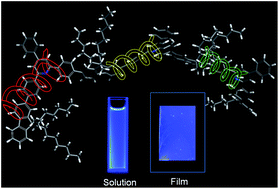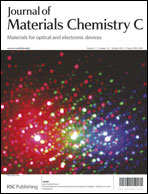Enhanced emission of organic and polymeric luminogens containing 2,4,6-triphenylpyridine moieties: crystallization- and aggregation-enhanced emission†
Abstract
Organic and polymeric deep-blue luminogens based on the 2,4,6-triphenylpyridine (TPP) structure were prepared via the facile Chichibabin reaction and their fluorescence behavior in relation to the aggregation-enhanced emission (AEE) properties were evaluated in this study. For the low-mass luminogens, the emission behavior of TPP and cyano-functionalized TPP (TPP-CN) in solvent–nonsolvent pairs was related to the crystallization-enhanced emission (CEE) behavior, which can also be verified by the enhanced emission in the crystalline structures developed by the solvent-fuming process. For a polymeric system, a low Mw PTPP oligomer consisting wholly of TPP repeating units and a PTPPF copolymer containing alternative TPP and 9,9-dioctylfluorene units were prepared through Suzuki coupling reactions and in contrast to TPP and TPP-CN, both of them were amorphous materials with strong solution fluorescence that remained relatively intact in different solvent–non-solvent mixtures. The constant emission behavior was therefore explained by the restricted molecular rotation of the rigid chain segments in PTPP and PTPPF. The solid PTPPF was a highly emissive material with a high quantum yield (ΦF) of 80%.


 Please wait while we load your content...
Please wait while we load your content...